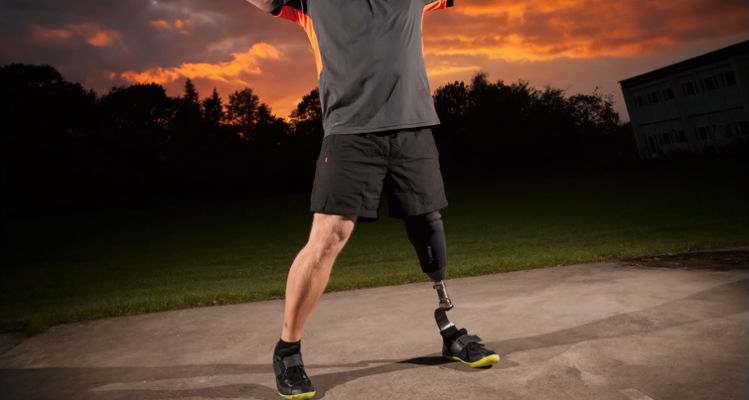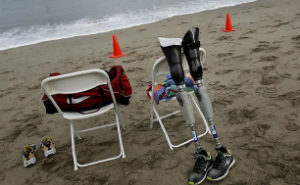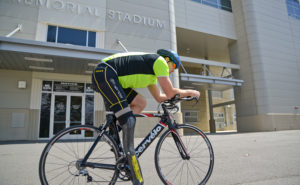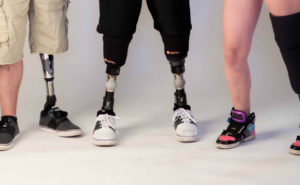Each patient who has undergone an amputation is unique, which means that each prosthetic limb must be custom designed and built to fit the patient’s body. The design and production process for prosthetics involves a number of steps to create an effective and functioning artificial limb.
Before the prosthetist can begin to design the prosthetic limb, he or she must take precise measurements. If possible, the prosthetist may begin to take measurements of the patient’s body before the limb is amputated and meet with the surgeon before the operation to get more details about the amputation.
Post-operatively, the prosthetist and the surgeon will decide upon the appropriate post-operative dressing, which usually consists of a compressive garment to aid in fluid evacuation of the residual limb which promotes healing. One may also benefit from an Immediate Post-Op Prosthesis to facilitate early-stage rehabilitation and weight-bearing.
After the wound has healed and the residual limb is devoid excess swelling, the prosthetist takes a plaster mold or fiberglass cast of the residual limb, which serves as a guide for building the prosthesis. Then the prosthetist transforms this hollow cast into a positive model of the patient’s limb using plaster, water, and vermiculite. Next, the prosthetist engages in the meticulous process of modifying the positive mold to reflect the envisioned design principles and to create a wearable interface. A clear plastic replica of the anatomical residual limb is developed from this modified mold, which will be used to test the fit of the prosthesis during the initial phases of fabrication.
Once the appropriate fit is achieved, the plastic socket will be transformed into a more durable carbon fiber or acrylic laminated socket and assembled to form the definitive artificial limb. Many things must be taken into consideration when designing the artificial limb such as the patient’s overall health and the location of muscles, tendons and bones in the residual limb. Most importantly, however, the prosthesis must be designed to meet the patient’s functional goals (i.e. Daily use, Walking, Running, Swimming, Skiing, Cycling, etc.) In the case of a lower limb, the prosthetist must also align the limb to fit the amputee’s unique gait pattern by making mechanical adjustments while the patient uses the limb in simulated situations.
How are Prosthetics Made?
A wide variety of materials are used to create the actual limb, including acrylic resin, carbon fiber, thermoplastics, silicone, aluminum, and titanium. To create a life-like appearance, a foam cover can be applied and shaped to match the real limb. A flexible skin-like covering will be applied over the foam to give it the life-like appearance. This feature, however, is not recognized as a medical necessity by most insurance providers, so the patient becomes financially responsible for the added cost of a “life-like” limb.
After the limb has been created, fitted, and delivered; adjustments over time are generally necessary to ensure proper fit is maintained. In the end, the goal is to create a limb that fits well and facilitates the patient’s lifestyle and targeted level of activity.
What Happens After the Prosthesis is Made?
After a patient is fitted with a custom prosthesis, he or she will undergo physical therapy to learn how to use the new limb and maximize success with the prosthesis. Physical therapy is an important part of the process, as learning to walk with a prosthetic leg and grip objects with a prosthetic arm can be extremely challenging. During physical therapy, patients can also learn how to use the prosthetic in everyday living situations.
A Variety of Prosthetic Options
Since prosthetics are meant to help amputees get back to their usual lives and activities of daily living, there are a variety of options. Prosthetics can be custom designed for many types of special uses. For instance, prosthetics for sports are custom built to help patients participate in certain types of sports, such as running or skiing. Prosthetic arms can be equipped with a wide range of accessories to enable a variety of tasks, such as eating with a fork, shooting a cross-bow, playing basketball, holding a pool cue…the options are endless!
If you or a loved one need a custom made prosthetic limb, contact Horton’s Orthotics & Prosthetics at (501) 683-8889 to schedule an appointment for a free consultation.



